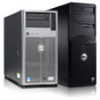Dell PowerEdge XL 5133-4 Dell PowerEdge M I/O Aggregator Getting Started Guide - Page 12
USB Console Port
 |
View all Dell PowerEdge XL 5133-4 manuals
Add to My Manuals
Save this manual to your list of manuals |
Page 12 highlights
USB Console Port Figure 1-3. USB Ports on Front Panel USB Storage Port USB Console Port Use the lower USB console port (Figure 1-3) to manage the switch through an RS-232 serial interface. This port provides a direct connection to the switch and allows you to access the command-line interface (CLI) from a console terminal connected to the port through the provided serial cable (with USB type-A to female DB-9 connectors). The console port supports asynchronous data of eight data bits, one stop bit, no parity bit, and no flow control. The default baud rate is 9600 bps. The upper USB port (Figure 1-3) functions as an external flash drive that you can use to store configuration files, scripts, and so on. 12 Hardware Overview

12
Hardware Overview
USB Console Port
Figure 1-3.
USB Ports on Front Panel
Use the lower USB console port (Figure 1-3) to manage the switch through an
RS-232 serial interface. This port provides a direct connection to the switch
and allows you to access the command-line interface (CLI) from a console
terminal connected to the port through the provided serial cable (with USB
type-A to female DB-9 connectors).
The console port supports asynchronous data of eight data bits, one stop bit,
no parity bit, and no flow control. The default baud rate is 9600 bps.
The upper USB port (Figure 1-3) functions as an external flash drive that you
can use to store configuration files, scripts, and so on.
USB Console Port
USB Storage Port














